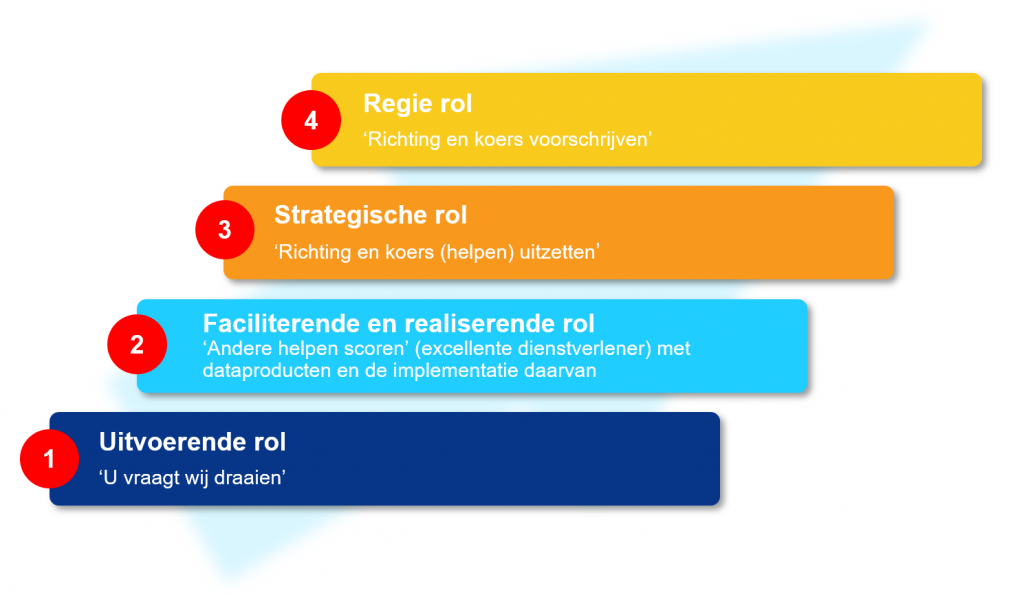Data is nothing … but
After all, data is nothing. Nothing but a collection of zeros and ones … until you do something with it! And keep repeating that so that you get a learning and adaptive organization. So then nothing becomes something very beautiful.
Two things to turn nothing into something: direction and get going!
To make something out of nothing, you have to do two things.
First, focus data – that is, translate it into insights and application and thus contribute to business strategy. Something that in practice sounds easier than it is. For this issue, we developed the Target to data model to get a focus on where data & analytics can develop the most value.
The second thing needed to develop long-term value with data is to set up your organization to work with it successfully. Making data work permanently requires a longer-term, structural and broader approach. How to do this and where best to start are covered in this article.
Making data-driven work permanent – broader than technology
With most organizations now “out of the dark” when it comes to the potential of data and having the first successful pilots, the question of how to embed it in the organization and what it takes to do so looms. And then not just from technology as in the early days of big data, but rather from a broader organizational perspective. Consider questions such as:
- how to shape a data department,
- Where do I hang it in the organization,
- what kind of people do I need,
- how many people, and
what exactly should they be able to do? - To answer these questions, we first look at the bigger picture of the data value chain and what it requires of organizations.
The data value chain and the role of director
To permanently cash in on the mountain of gold that data seems to be, organizations must succeed in mastering the data value chain and optimizing it.
This requires mastering all organizational aspects. Of people, organization, processes, data and systems. And where data and its organizational entities have often been executive to date, you want to move up in maturity to strategic issues. To ultimately directing based on facts.Levels of ambition data strategy
Organizational aspects in balance: the chain is as strong as its weakest link
As the role of data shifts from supporting to strategic or even directing, it demands that organizations develop all of these aspects in balance. You can have skilled analysts on staff, but if the business can’t grasp it or apply it, it’s not going to work.
You can have good data, but if your process to process it is manual, you will never develop the speed to apply this data successfully. You can have a culture where people dare to experiment and undertake. Helping it successfully enter the organization only works if people work together and are not entrenched in organizational silos. And the above reasoning can be applied to any imbalance in the various maturity aspects of the organization.
The combination of different levels of ambition coupled with the different organizational aspects combine to form a powerful tool for determining ambitions and organizational impact. And in doing so, target and manage the needed change in a cohesive way. Once you know what aspects you need to change on and what gaps there are to close, the next valid question is, where to start?

Success begins with people! – four factors for success with the human touch
Experience shows each time that success is impossible without the human factor. This falls into four aspects:
- It starts with leadership: board belief and sponsorship to shape the move to data-driven work
- Then the right people who come from data to insights and understand where data can add value. So subject mature analysts and data scientists who have enough business knowledge to get to the core. You can recruit these newly or develop them with training, education and coaching from the talent already present in the organization.
- And the people who can apply the insights – the business – and increase value by asking the right follow-up questions. This very part is often still underestimated. But just as analysts need to be able to bridge to business issues, business people also need to evolve to get a feel for the potential and application of data and insights. Calling out of ignorance that you “want to know everything” when asked by a BI department what you would like to know to do your job better is not going to help….
- And last but not least … collaboration: connecting the previous factors into an organizational form and culture that ensures that the organization will become learning and adaptive. In order to be successful in the increasingly challenging landscape in which the company operates.
The path to turning nothing into something beautiful – Data Strategy
For organizations, there is indeed a clear path to follow to turn nothing into something and make data work. We are happy to help take the first steps in this. In the form of developing a data strategy or an assessment on existing situations and strategies. And, of course, by supporting it with the right people, because as mentioned, that is one of the most important sources of success. From thinking to doing with each other!
In addition to the people side, organizational design and creating the right culture also play an important role. If you want to read more about this check out our articles about it.
Culture, the true key to success in data-driven work?
Implementing data strategy successfully: the organizational setup




